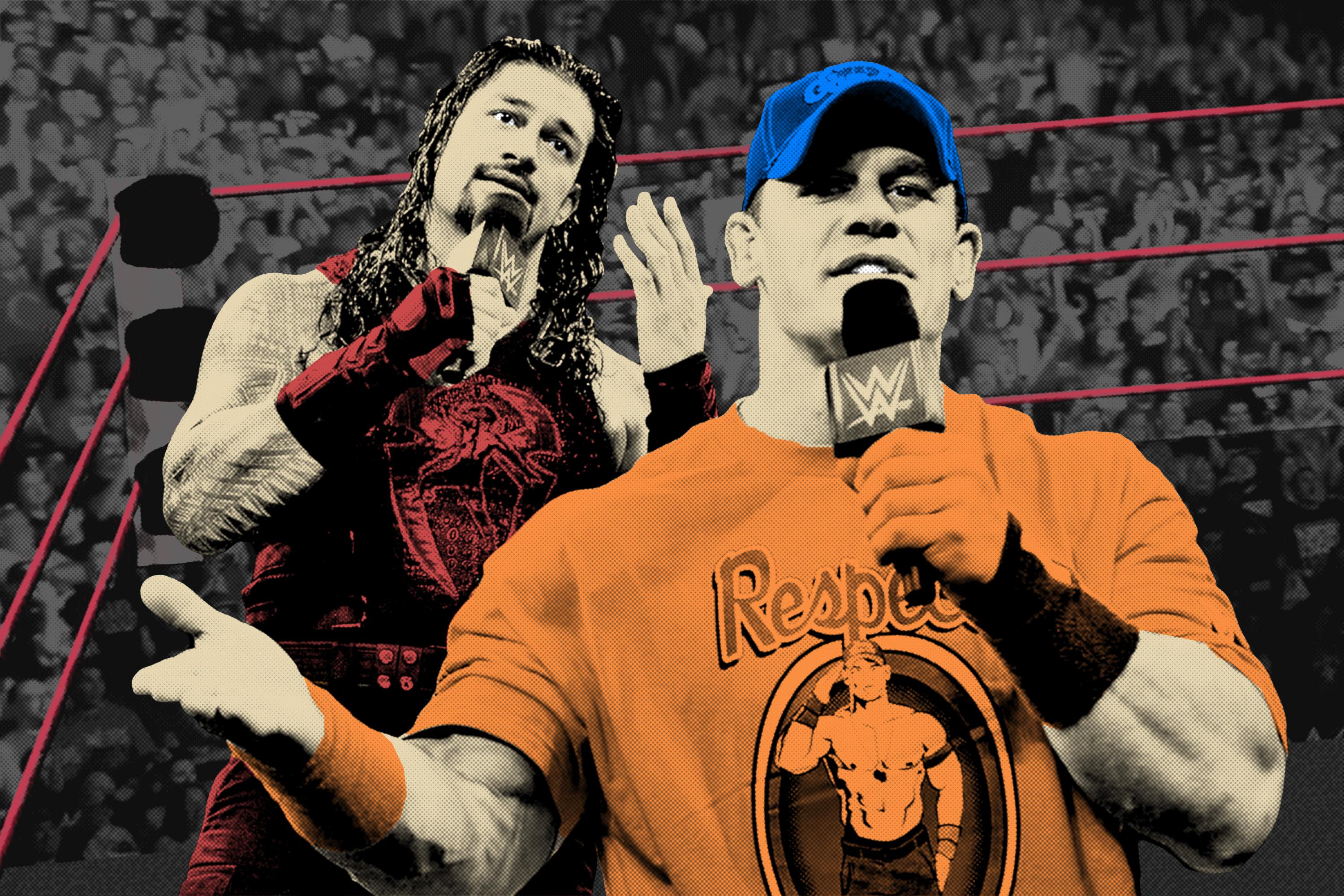
Last week on Raw, John Cena exercised his free-agent status and jumped ship from WWE’s Tuesday show, SmackDown Live. Normally, this could be seen as a craven move to get WWE’s biggest star on its next pay-per-view (No Mercy is Raw-only), but this was immediately something more than a guest-star role. In the face of a characteristically uneven welcome from the Brooklyn crowd, Cena didn’t waste time. He didn’t call out a stock villain (old-school Cena’s stock and trade) or an up-and-comer (the go-to move of his contemporary shtick). Instead, he immediately called out the post-Cena face of the company: Roman Reigns.
In another era, this would be Hulk Hogan vs. the Ultimate Warrior—the inevitable clash of two epochal heroes. Now, though, it’s Mayweather-McGregor, the big-money clash of two flawed, almost inexplicable megastars. When Cena appeared last Monday, he was lustily booed; since the postmodern era of pro wrestling took hold, the competing chants of “Let’s go Cena!” and “Cena sucks!” have come to define the audience split between the regular fans and the superfans. It’s those who are easily swayed by Cena’s Wonderbread charm pitted against those hardened to wrestling’s simplistic style. (It’s both fitting and absurd that the diehards are nominally immune to the base conceit of the form, but whatever.) Cena has earned the grudging respect of the smarks over the past several years, but they still chant “Cena sucks!” at him, both as an ironic term of endearment and as a jab at the WWE office. That was always the point of fans turning on Cena—sure, he did suck, but WWE inorganically overexposing him at the expense of everyone else on the roster was far worse.
That the mind-set that led to Cena’s interminable push hasn’t changed is evidenced by the more recent ascent of Reigns, whose entire singles run has been ham-handed and generally despised. While he got his fair share of cheers at first—he had the benefit of keeping the trappings of the super-popular Shield when the group split up, and there’s no denying that he looks the part—even the marks caught on and started booing Reigns eventually. WWE caught on, too, and started presenting him as a low-key heel. Where Cena grinned at the boos, Reigns snarled. It was a subtle pivot from his previous antiheroic persona, and it didn’t take a devilish moment to accomplish. As one high-ranking WWE exec told me, “He’s already the biggest heel in the company. Why mess with success?”
In the modern WWE, the only way to really be a heel is to be legitimately resented or despised, because to get the smark buy-in, you have to piss them off at the same time you enrage the little kids. We boo respectfully at Alexa Bliss or Paul Heyman, but the most hated performers in WWE are the heroes who got top billing without deserving it—or being perceived to deserve it, at least. (This also accounts for much of the hatred of Stephanie McMahon and her husband, Triple H, who stand to inherit the company.)
Last week on Raw, when Cena and Reigns met in the ring, it felt like WWE was finally acknowledging the disconnect. The only thing Cena and Reigns have in common is that they’re failed poster boys for the company, ostensible heroes who get more boos than cult leaders and monstrous savages. This was underscored when they were joined in the ring by the Miz, one of the purest retro heels on the roster, who was serenaded with cheers when he decried the amount of screen time allocated for Reigns and Cena.
“In life, you’re always told that if you work hard, if you chip away, if you plug away, and if you do your job, then your moment will come. I am sick of waiting for my moment while two undeserving people like you two get moments week after week after week.” In another day and age we’d call that a worked shoot—the ephemeral art of pretending to go off script—but in the post–CM Punk era, it was just a heel mouthing off. But it still felt like a breath of fresh air: Finally, someone was saying what we were all thinking. (Miz is one of those “we boo him politely” performers, but it must be noted that, despite his current greatness, he’s still burning off a decade of bad will for being force-fed to fans like a villainous proto-Reigns.)
On Monday, Cena and Reigns said it themselves. In a scene that played out like Aaron Sorkin fantasy-booking in a wrestling chatroom, Cena laid into Reigns for being a “cheap-ass corporately created John Cena bootleg.”
“He ain’t the guy,” Cena snarked, referencing Reigns’s laughably uninspired nickname. “Dude, you’re just a guy. A guy trying so desperately to fill shoes that you never will.” This was the worked shoot the modern wrestling fan had been waiting for.
After an early dropped line (which actually underscored the realness of the moment), Reigns fired back, “You’re not as big a deal as you think you are,” calling him a “Yes-man” and a “part-timin’ fake bitch.” He echoed some of the Miz’s proletariat complaints from the previous week (which themselves echoed some of Cena’s grievances with the Rock from back in the day): “I’ll be damned if I don’t bust my ass Friday-Saturday-Sunday-Monday every single week so you can hang out on the Today show.”
The live audience was getting behind Cena as they found a common enemy in Reigns, and it was hard to deny the truth of Cena’s argument. Even if we’d rather see some other guys at the top of the card, “I’m still here because you can’t do your job” rang true; Cena could have stayed on SmackDown, after all. But just as the crowd was about to carry Cena out on its shoulders, Reigns scored one lethal shot. “You know what irritates you about me?” he asked. “You can’t bury me, John.”
Even though Cena has spent the last act of his career helping new talent get over, he sat atop a static hierarchy for so long that the barb sticks. He might not have the reputation of demanding wins at the expense of his opponents that, say, Triple H does (though he’s not entirely clean), but if you read “bury” not as an unwillingness to put other guys over but an inability to, it’s a tough critique. Cena’s persistence as the company’s top babyface and the inability to build him an equal is damning; Edge’s shortened career was a tragedy on this count, as was Punk’s departure, but after those two you’d have to stretch to make an arch case for the Miz. It wasn’t until Punk was gone that Cena realized what had been missing from his career the whole time. He had plenty of rivals in story lines, but none in any literal sense of the word. When Cena shifted his career toward helping the next generation of stars, the programs transitioned in a very real sense from work to shoot. The matches weren’t about some theatrical idea of victory, they were about actual success.
When CM Punk cut the worked-shoot promo that launched the postmodern era back in 2012, the ensuing feud drove Cena to be a better in-ring wrestler, and certainly brought out some of the best promos of his career. But on Monday night, Cena finally seemed to have mastered the moves that Punk was kicking his ass with. (He also at one point yelled “See ya, fourth wall!” proving that only John Cena can make a worked shoot corny.)
Too often, the problem with pro wrestling is the lack of introspection and self-awareness. John Cena’s been valiantly absorbing the boos for years, even as he strove to defy the knocks on him as a worker. But it wasn't until Monday's assault on Reigns that he showed he was tuned in to what the boos were trying to say. When he called Reigns a “John Cena bootleg” he was implicitly accepting all of his other insults upon himself. Fans everywhere are asking whether Monday’s dialogue was “real” or not, and that’s all the evidence you need to say that the segment was a roaring success. That’s what a worked shoot does—it evokes the same state of deep-seated anxiety that a bad guy pounding on your hero’s head did when you were a kid. The answer, if it needs to be said, is yes: that was both real and not real, and WWE knew it was sending them out there to say real things within the context of their televised unreality. That doesn’t make the segment less interesting—it makes it hopeful.
There was a forgettable moment in the scene where Reigns said to Cena, “So maybe it’s not that I don’t want to fight you. Maybe I just don’t need to.” This is fairly standard heel shtick, and was overwhelmed by what came after. But it was telling, because if Reigns is the living embodiment of the front office’s misbegotten plans, this is a pretty straightforward takedown of what was perceived to be WWE’s organizing philosophy prior to last week: Why would we put Cena and Reigns together when they’re our two biggest heroes? In that sense, this wasn’t a worked shoot—it was an intervention.
But beyond that, there’s the question of control. Why put ourselves at the mercy of the fans, you imagine WWE executives asking, whose reactions can’t be predicted? By the end of the segment, Reigns has signed the contract to fight Cena, and WWE had answered his question clearly: they do need them to fight. WWE had given up on micromanaging the futures of Cena and Reigns. The fans will cheer and boo as it suits them.
There are plenty of fans out there celebrating Monday’s segment as Reigns’s official heel turn. But in taking the guff from Cena, by agreeing to the angle in the first place, he’s implicitly exhibiting self-awareness—and so is WWE, which is the real target of Reigns’s boos. In the end, this might be the perfect ploy to get him over as a babyface. And how wonderfully ironic it would be if John Cena—the man whose career Reigns’s is modeled on—were the one to make it happen.
This will certainly be a turning point for Reigns, whether or not he gets some cheers out of it. But just as the “Cena sucks” contingent is cautiously cheering him now, my guess is that diehard fans are ready to accept Reigns. He’s already a better wrestler than Cena was in 2012, and fans know we’ve been giving him too much grief. The problem is WWE’s, after all. With WWE publicly airing the grievances of the everyfan via Cena, the biggest knocks on Reigns are moot. (The lingering question is when and if they pivot to the seemingly inevitable Reigns vs. Lesnar WrestleMania match, because as soon as that happens, the good will evaporates.) The Miz may have been shuffled aside from the main event picture again, but his words ring true: “If you work hard, if you plug away, if you chip away, if you do your job, then your moment will come.” The moment for the Cena-Reigns reclamation project is now.
In the old days, wrestlers worked out disagreements in the ring, and in doing so worked out the fans’ existential anxieties. Now every match is an opportunity to solve the company’s existential problems—how do we make wrestling matter in 2017?—and the fans’ solitary anxiety: will they give us what we want?
Later in the show, announcer Michael Cole said that Cena and Reigns had been “shooting from the hip,” but he was quickly corrected by boothmate Corey Graves: no, they were “shooting from the heart.” In 2017, there isn’t anything that comes out of the announcers’ mouths that isn’t the corporate line. Oftentimes it leads to monotony, but it can be illuminating. It wasn’t a shoot—it was a worked shoot. For once, the ending doesn’t feel predetermined. WWE knew what it was doing. That’s something to get excited about.

